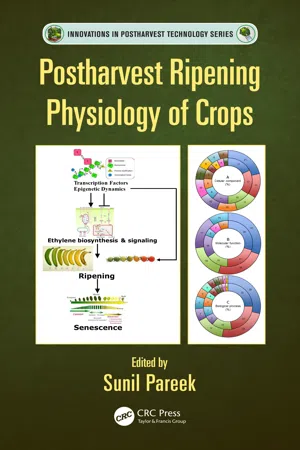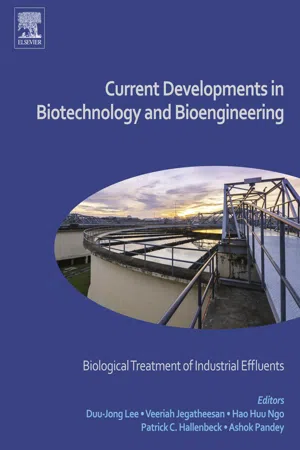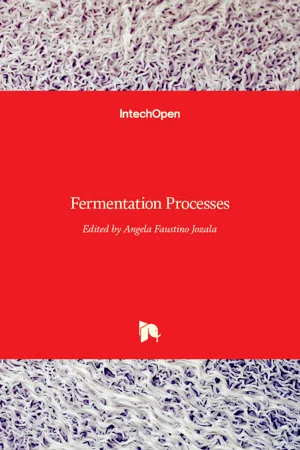Biological Sciences
Anaerobic Respiration
Anaerobic respiration is a metabolic process that occurs in the absence of oxygen, producing energy for cells. It involves the breakdown of glucose into pyruvate, followed by the conversion of pyruvate into other compounds such as lactic acid or ethanol, releasing energy in the form of ATP. This process is less efficient than aerobic respiration but is essential for organisms in low-oxygen environments.
Written by Perlego with AI-assistance
Related key terms
1 of 5
7 Key excerpts on "Anaerobic Respiration"
- Cecie Starr, Christine Evers, Lisa Starr, , Cecie Starr, Cecie Starr, Christine Evers, Lisa Starr(Authors)
- 2020(Publication Date)
- Cengage Learning EMEA(Publisher)
fermentation Any of several anaerobic pathways that break down organic molecules (typically glucose) to produce ATP without the use of an electron transfer chain. glycolysis Set of reactions that collectively convert one molecule of glucose to two molecules of pyru- vate, for a net yield of two ATP and two NADH. Copyright 2021 Cengage Learning. All Rights Reserved. May not be copied, scanned, or duplicated, in whole or in part. Due to electronic rights, some third party content may be suppressed from the eBook and/or eChapter(s). Editorial review has deemed that any suppressed content does not materially affect the overall learning experience. Cengage Learning reserves the right to remove additional content at any time if subsequent rights restrictions require it. RELEASING CHEMICAL ENERGY CHAPTER 6 109 as aerobic respiration. Aerobic respiration is much more efficient; you and other large, multicelled organisms could not live without its higher ATP yield. Glycolysis: Sugar Breakdown Begins Aerobic respiration and fermentation begin in cytoplasm, with glycolysis. Glycolysis is a series of reactions that produce ATP by converting one molecule of glucose to two molecules of pyruvate, an organic compound with a three-carbon backbone (Figure 6.4). Energy-Requiring Steps A cell invests two ATP in the energy-requiring reactions that begin glycolysis. These reactions convert one (six-carbon) glucose to two mol- ecules of the three-carbon sugar PGAL. First, a phosphate group is transferred from ATP to the glucose, so glucose-6-phosphate forms 1 . A phosphate-group transfer from a second ATP 2 produces an intermediate that splits to form two molecules of PGAL 3 . Both PGAL molecules continue in the next reactions. Energy-Harvesting Steps The remaining reactions of glycolysis harvest energy from the two PGAL molecules. A second phosphate group is attached to each PGAL, and during this reaction electrons and hydrogen ions end up in NADH 4 .- eBook - ePub
- Rodney P. Anderson, Linda Young(Authors)
- 2016(Publication Date)
- Wiley(Publisher)
lactic acid fermentation. As with alcoholic fermentation, humans have used microorganisms that perform these reactions to make different food products such as yogurt and some cheese varieties.Even with faster, deeper breathing during strenuous exercise, oxygen levels are quickly depleted by working muscle cells, creating temporary anaerobic conditions. This requires them to perform lactic acid fermentation to regenerateNAD+and continue ATP production via glycolysis. The burning sensation in muscles during an intense workout results from irritation caused by hydrogen ions released from accumulating lactic acid. When activity levels return to normal, adequate oxygen levels are restored to muscle tissues, lactic acid is catabolized, and muscle cells again perform cellular respiration.1.Whyis glucose catabolism a multistep process when its potential energy could be liberated in a single step?1.Whatis the principal function of fermentation in anaerobic microorganisms?7.4 Aerobic Cellular Respiration
LEARNING OBJECTIVES
1.Describethe overall reactions of pyruvate oxidation and the citric acid cycle.2.Explainthe reactions of the electron transport system.3.Describethe catabolism of lipids and proteins4.Explainhow the metabolic pathways for carbohydrates, lipids, proteins, and nucleic acid intersect.A s the concentration of oxygen in early Earth’s atmosphere continued to increase, some microbes evolved new metabolic pathways that permitted them to use this new resource for enhanced ATP production. Oxidative phosphorylation continues the degradation of glucose started in glycolysis and simultaneously regenerates theNAD+ - eBook - PDF
- Rodney P. Anderson, Linda Young, Kim R. Finer(Authors)
- 2020(Publication Date)
- Wiley(Publisher)
As with alcoholic fermenta- tion, humans have used microorganisms that perform these reactions to make different food products such as yogurt and some cheese varieties. Latic acid ferementation is also found in humans. Even with faster, deeper breathing during strenuous exercise, oxygen levels are quickly depleted by working muscle cells, creating temporary anaerobic conditions. This requires them to perform lactic acid fermentation to regenerate NAD + and continue ATP production via glycolysis. The burning sensation in muscles during an intense workout results from irritation caused by hydrogen ions released from accumulating lactic acid. When activity levels return to normal, adequate oxygen levels are restored to muscle tissues, lactic acid is catabolized, and muscle cells again perform cellular respiration. Concept Check 1. Why is glucose catabolism a multistep process when its potential energy could be liberated in a single step? 2. What is the principal function of fermentation in anaerobic microorganisms? 208 CHAPTER 9 Metabolism 9.4 Aerobic Cellular Respiration LEARNING OBJECTIVES 1. Describe the overall reactions of pyruvate oxidation and the citric acid cycle. 2. Explain the reactions of the electron transport system. 3. Describe the catabolism of lipids and proteins. 4. Explain how the metabolic pathways for carbohydrates, lipids, proteins, and nucleic acids intersect. Approximately 1 billion years ago, as the concentration of oxygen in early Earth’s atmosphere continued to increase, some microbes evolved new metabolic pathways that permit- ted them to use this new resource for enhanced ATP produc- tion. Oxidative phosphorylation continues the degradation of glucose started in glycolysis and simultaneously regenerates the NAD + consumed. When glucose is completely oxidized to water and carbon dioxide in the presence of oxygen, its electrons reduce activated carriers that ultimately participate in the redox reactions of chemiosmosis. - eBook - PDF
- Sunil Pareek(Author)
- 2016(Publication Date)
- CRC Press(Publisher)
141 R E S P I R A T O R Y M E T A B O L I S M to capture reducing power (e.g., in NADH), and to produce small carbon fragments from which more complex molecules can be synthesized. In the presence of adequate levels of oxygen, the three sequential respiratory reactions are glycolysis (i.e., the lysing of glucose to produce pyruvate), the tricarboxylic acid cycle (i.e., the decarboxylation of pyruvate to CO 2 and production of high-energy compounds, e.g., NADH), and electron trans-port (i.e., generation of ATP from high-energy compounds by chemiosmotic phosphorylation). An offshoot of glycolysis, the pentose-phosphate shunt diverts and reconfigures intermediates from glycolysis into substrates for subsequent synthetic reactions (e.g., produces the 5-carbon ribose sugars used in RNA and DNA synthesis). In the absence of oxygen, NAD + regener-ated during Anaerobic Respiration allows glycolysis to continue to extract a portion of the energy contained in the glucose molecule. Biological energy is stored and released through redox reactions. Respiratory metabolism involves the transfer of energy in a substrate mol-ecule (e.g., glucose) through the extraction and movement of electrons. Redox (shorthand for reduction–oxidation reactions) involves a coupled reaction where electrons are gained by a molecule (i.e., it is reduced) while another molecule is oxidized (i.e., it loses electrons). In aerobic respira-tion (i.e., in the presence of adequate oxygen), glucose is oxidized (i.e., it furnishes high-energy electrons) and some of the energy in the electrons is extracted in the production of ATP as they pass through a number of enzymatically controlled steps, until they finally reduce oxygen to water (i.e., transfer the electrons, with the accompanying protons, to oxygen). - eBook - ePub
- H. W. Doelle(Author)
- 2014(Publication Date)
- Academic Press(Publisher)
4Anaerobic Respiration
Publisher Summary
This chapter focuses on the Anaerobic Respiration. Anaerobic Respiration refers to the first group of chemosynthetic bacteria includes all those bacteria that perform energy-yielding reactions in which inorganic compounds other than oxygen act as terminal acceptor. It is an anaerobic process, which means that all bacteria carrying out this type of respiration are either strictly or facultative anaerobes. Three main groups of bacteria are known to use an inorganic compound as terminal electron acceptor: (1) Desulfovibrio or Desulfotomaculum , using sulfates as terminal electron acceptor; (2) the heterogeneous group of denitrifying bacteria, using nitrate as terminal electron acceptor; and (3) Methanobacterium , using carbon dioxide as terminal electron acceptor. The first two groups of bacteria are very closely related in their electron transport systems but differ in that the sulfate-reducing bacteria do not possess nicotinamide adenine dinucleotide. This difference in the electron transport systems also reflects that between the strictly anaerobic sulfate reducers and the facultative anaerobic group of denitrifiers.It has been shown in the preceding chapter that photosynthetic bacteria obtain their energy from light, transfer it via cytochromes, and finally store it as ATP. Their reducing power comes from the substrate, however; i.e., the exogenous hydrogen donor. The majority of microorganisms, however, obtain their energy from chemical reactions and are called, accordingly, “chemosynthetic bacteria.” We shall now deal with the various kinds of chemosynthesis.On comparative biochemical grounds, the energy system of the chemosynthetic bacteria is very much like that of the photosynthetic bacteria and consists of a cytochrome system coupled to phosphorylation, which generates ATP. Light, as the source of the highly energized electrons, is replaced by a great number of chemical compounds, the utilization of which is extensively used for classification purposes. In chemolithotrophs, the whole system is driven by the oxidation of inorganic compounds, whereas in chemoorganotrophs this system is driven by the oxidation of organic compounds. As in photosynthesis, three general processes must be considered in the study of biological oxidations (51 ): (1 ) the dehydrogenation of a substrate, followed by the transfer of the hydrogen or electron to an ultimate acceptor; (2 ) conservation of the energy released in step (1 ); and (3 - eBook - ePub
Current Developments in Biotechnology and Bioengineering
Biological Treatment of Industrial Effluents
- Duu-Jong Lee, Patrick C. Hallenbeck, Huu Hao Ngo, Veeriah Jegatheesan, Ashok Pandey(Authors)
- 2016(Publication Date)
- Elsevier(Publisher)
[1] . Microbial metabolism can be carried out under both aerobic and anaerobic conditions.8.1.1. Aerobic Metabolism
Aerobic treatment is an oxidation process whereby bacteria degrade organic matter and other pollutants in the presence of oxygen. Aerobic decomposition of organic substances is usually considered to consist of fermentation and respiration (or oxidation), biosynthesis, and endogenous respiration. The end products of the oxidation process consist of carbon dioxide, ammonia, energy, water, and other end products as represented in Eq. [8.1] , in which COHNS (carbon, oxygen, hydrogen, nitrogen, and sulfur) represents the waste organic compound in general:COHNS + O2 + aerobes → CO2 + H2 O + NH3 + other end products + energy[8.1]Simultaneously, some of the wastes are converted into new cell tissue using part of the energy released during oxidation through the synthesis process (Eq. [8.2] ). The mechanisms and kinetics of aerobic decomposition are well established on account of a good understanding of aerobic biochemistry and microbiology:COHNS + O2 + aerobes + energy → C5 H7 NO2 (new cells or sludge)[8.2]Biodegradable compounds are high-energy forms of organics. The oxidation of such compounds to low-energy forms such as carbon dioxide provides energy for the microorganisms. Understanding how to mix aerobic microorganisms, soluble organic compounds, and dissolved oxygen for high-rate oxidation of organic compounds is part of the fundamental knowledge of wastewater engineers. - eBook - PDF
- Angela Faustino Jozala(Author)
- 2017(Publication Date)
- IntechOpen(Publisher)
These two stages occur under different conditions and are carried out in separate bioreactors. Keywords: anaerobic digestion, microorganisms, hydrogen, methane, syntrophy, re-newable energy © 2017 The Author(s). Licensee InTech. This chapter is distributed under the terms of the Creative Commons Attribution License (http://creativecommons.org/licenses/by/3.0), which permits unrestricted use, distribution, and reproduction in any medium, provided the original work is properly cited. 1. Introduction Anaerobic digestion of biomass under mesophilic conditions (anaerobic microbial decomposi-tion/degradation of organic matter), whose final products are methane and carbon dioxide, contributes to the energy flow and circulation of matter in ecosystems. It is a key process in the global carbon cycle that is promoted by the activity of many different groups of microorganisms. Anaerobic digestion commonly occurs in natural anoxic ecosystems such as freshwater sediments, wetlands, marshlands, paddy fields and deeper zones of marine sediments. The digestive tracts of animals, especially ruminants and termites, are also sites of methane production by this process. It is estimated that biological methanogenesis is responsible for more than 70% of total global methane emissions [1, 2]. Anaerobic decomposition of biomass to carbon dioxide and methane only occurs in anoxic environments with a low redox potential, i.e., where concentrations of other electron acceptors including nitrate, oxidized forms of metals such as Mn(IV) and Fe(III) or sulphate are low. The inhibition of anaerobic digestion by nitrate, oxidized metal ions and sulphate is determined by the redox potential. As shown in Figure 1 , a decrease in redox potential leads to changes in the dominant type of Anaerobic Respiration towards low energy-yielding processes. The nature of the final electron acceptors present in an environment is a key factor in determining the ecological niches for particular microorganisms.
Index pages curate the most relevant extracts from our library of academic textbooks. They’ve been created using an in-house natural language model (NLM), each adding context and meaning to key research topics.






